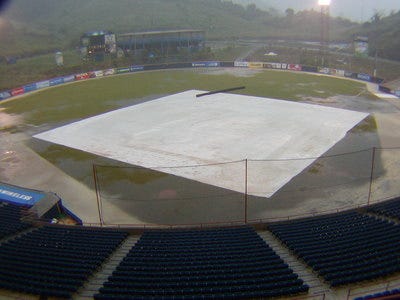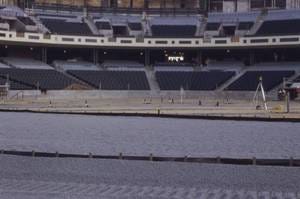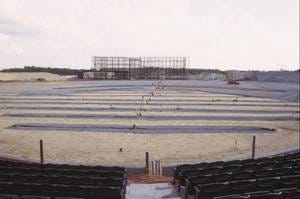HOW DO BASEBALL FIELDS DRAIN SO FAST?
By MC

With the recent storms across the US many ballparks have been hit by heavy downpours of rain. A blog reader sent me a note asking how the field drains so quickly. He mentioned a 2 or 3 inch rain at a MLB Stadium and was amazed at how quickly the water disappeared after it stopped. (This ballpark photo was in Panama City, Panama where we held an Olympic Qualifier…actually this field was ready to go after we unclogged the drains about an hour after it stopped raining because of a pretty good drainage system and a great groundcrew.)
Here’s the short answer about how a field drains so fast: About 20 years ago, “sand based field construction” was introduced to many sports including baseball due to the high occurrence of rain outs and poor playing conditions In many cases the fields became very unsafe for players not mention the lost revenues from ticket sales. The concept of sand based fields has been around for many years in the golf course industry. Golf Greens are designed specifically to drain using a protocol developed by the USGA. Other sports have used the sand based protocol from the USGA Specification and have Modified it for other sport surfaces.
The typical sand based field is composed of 4 layers.
1. Sub-grade — this layer is normally 12 to 16 inches below the surface. Its pretty much the native soil or fill that the field is built on.

2. Drain and Gravel Layer — This layer is composed of two components. One is drain pipe. The drain pipes are installed in the sub-grade layer and cross the ENTIRE field about every 20 feet. Each have a slight fall of about 1% that allows the water to naturally flow in the pipe. These pipes connect into a larger drain pipe that runs into the storm water system. A special gravel is then placed around the pipe and about 4 inches of the gravel is spread over the entire field. Sometime this is layer can be about 3000 to 4000 tons of gravel.
3. Sand or what we call in the industry the “Root zone”. This layer is normally about 10 to 14 inches in depth and is composed of a specific blend of Sand and Peat Moss. In some areas they just use straight sand depending on what type of turf. This material is placed over the entire gravel layer. Again the sand is designed to “bridge” with the gravel so it doesn’t fall through and make the field uneven. This layer is somewhere between 4000 and 6000 tons of sand!
4. The grass — Well this layer is normally just sod or sprigs and is placed directly on the sand. SOmetimes it is even a sand basedgrass to keep the materials consistent.
These systems have pretty much become standard in sports-field and baseball field construction if you have the budget to build one. Basically these fields are just one big 2 acre putting green that can drain 7 to 10 inches of rain water per hour!

I remember when we built the Disney’s Wide World of Sports Complex we had to bring in 750,000 tons of orange grove sand to spread over the site. Granted it was in Florida and the complex is only 100 acres…. but that amount of sand raised the entire site about 4 feet. This was our subgrade before we built the field on top of it.
There are a lot of variations of this system out there but the key to the fields draining is what is installed underneath the surface.
Anyway… hope that gives you an idea of how that water runs off the field so fast!

